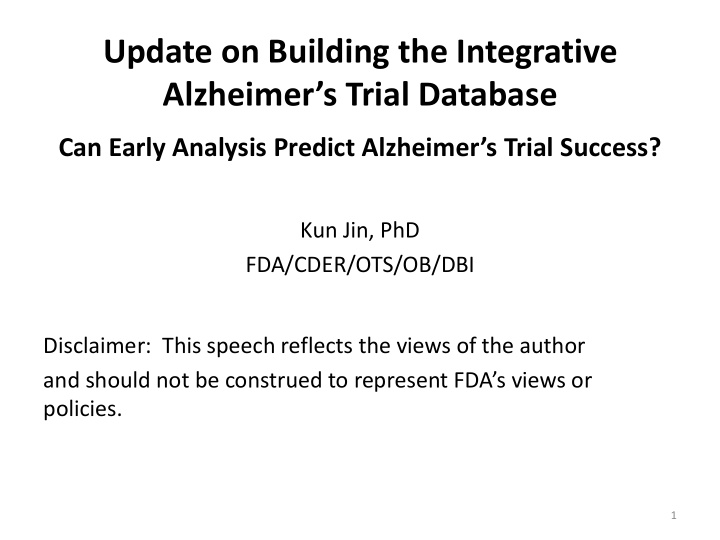



Update on Building the Integrative Alzheimer’s Trial Database Can Early Analysis Predict Alzheimer’s Trial Success? Kun Jin, PhD FDA/CDER/OTS/OB/DBI Disclaimer: This speech reflects the views of the author and should not be construed to represent FDA’s views or policies. 1
• Current Status on Integrative Alzheimer’s Trial Database (IATD) • Interesting Results Can Early Analysis Predict Alzheimer’s Trial Success? • Future Work 2
Current Status on IATD • Background The FDA CDER has an extensive collection of data from Alzheimer’s disease trials made available through NDA, BLA, and Supplement submissions IATD will assist the Agency in making data-driven regulatory judgments regarding the design of future clinical trials in Alzheimer’s disease It will also help sponsors improve the design of clinical trials in Alzheimer’s drug development 3
• Current Status Two ORISE Fellowship students worked in the summers of 2013 and 2014 Less than 20 of original NDAs and NDA efficacy supplements for Alzheimer’s Disease were gathered over 11,000 patients and more than 140,000 observations The names of the primary endpoints, key secondary endpoints, and some of the important demographic variables and covariates were standardized The results for most studies were consistent with the results in the study reports, except for one 4
Can Early Analysis Predict Alzheimer’s Trial Success? Preliminary Results • Placebo-controlled studies with data available for ADAS-Cog and CIBIC-Plus scores were used • Interim analyses were conducted when 1/4, 1/3, and 1/2 of patients had completed for each arm • The maximum p-value from the three analyses was selected as a predictor for each arm 5
• With these predictors, the “winning” and “failing” treatment arms could be separated by a number between 0.4 and 0.5 using the ADAS-Cog score. However, the CIBIC Plus, did not clearly separate the “winning” and “failing” treatment arms. _W__W__W_W__W__W _________ F__F___F__F_ 0 1 6
Implications: • Sponsors are increasingly incorporating a futility interim analysis in their study design. The interpretation of the results may be difficult. The result of a global measure is unlikely to be informative, and therefore should not be used to decide the fate of an investigational product. • The finding indicates that the relative strength of these two types of co-primary efficacy measure may not be the same. A comprehensive review of the relative strength of evidence of these two types of primary efficacy measure with the IATD may help the Agency decide whether or not the regulatory standard should be altered. 7
Future Work • A Critical Path Research Funding proposal was sent • A number of studies in pilot database lack major efficacy endpoints, like ADAS-Cog, CIBIC-Plus, ADCS-ADL, and MMSE. Some may be derived from the raw data sets. • Need to add these NDAs submitted before the current electronic dataset standards introduced • More metrics will be generated from all efficacy endpoints in order to find robust signals for predicting success or failure in efficacy trials 8
• Fit a class of parametric or semi-parametric models for the longitudinal curves of cognitive scores. It will provide a foundation for the future trial designs for disease modification claim. • Avoiding pitfalls from chance finding using limited data • Frame work for sponsors to share their data, particularly these data from failed clinical trials? 9
A Pathway to “Early” • The IATD contains information in patients with mild to severe Alzheimer’s disease • Can we learn, or extrapolate something from the IATD to the population of early Alzheimer’s patients? • Validations can be carried out from “Severe” to “Moderate” “Moderate” to “Mild” 10
Acknowledgement • Summer Students Changming Xia, University of Rochester Minming Li, University of Massachusetts • FDA ORISE Fellowship Program 11
Recommend
More recommend